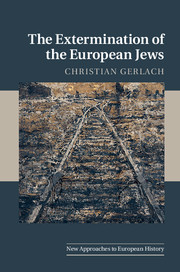Book contents
- Frontmatter
- Contents
- List of tables
- Acknowledgments
- List of abbreviations
- 1 Introduction
- Part I Persecution by Germans
- Part II Logics of persecution
- 7 Racism and anti-Jewish thought
- 8 Forced labor, German violence and Jews
- 9 Hunger policies and mass murder
- 10 The economics of separation, expropriation, crowding and removal
- 11 Fighting resistance and the persecution of Jews
- Part III The European dimension
- Bibliography
- Index
8 - Forced labor, German violence and Jews
from Part II - Logics of persecution
Published online by Cambridge University Press: 05 March 2016
- Frontmatter
- Contents
- List of tables
- Acknowledgments
- List of abbreviations
- 1 Introduction
- Part I Persecution by Germans
- Part II Logics of persecution
- 7 Racism and anti-Jewish thought
- 8 Forced labor, German violence and Jews
- 9 Hunger policies and mass murder
- 10 The economics of separation, expropriation, crowding and removal
- 11 Fighting resistance and the persecution of Jews
- Part III The European dimension
- Bibliography
- Index
Summary
Many scholars have argued that the murder of Jews in Europe defied all economic logic, violated Nazi economic interests and contradicted their war effort. Blanket statements about, for example, the “fundamentally anti-economic character of the [Nazi] genocide” are popular but untenable. Others have offered arbitrary and contradictory interpretations about what had primacy – the war economy or racist ideology. This shows how problematic it is to ask simplistic either/or questions in this context. It is more fruitful not to take economics and ideology as opposites. There were complex interrelationships between the two.
This chapter deals with the labor factor in relation to Jewish and other forced labor. But it is important to understand that economic considerations related to the killing of Jews were not about labor alone. Further chapters will treat the connections between food, housing, settlement, finance and transportation policies and the persecution and extermination of Jews. They will show that some economic factors tended to spur the murder of Jews in crucial ways, while others, such as labor and transportation, were obstacles to it. Contradictions between economic interests and the destruction of Jews were more limited than is often assumed. And severe contradictions emerged between different German economic interests (e.g., labor versus food, labor versus housing and transportation versus housing). The fundamental situation underlying all these issues was scarcity. Modern economies in major wars are economies not of surplus but of want, shortages and restraints. Moreover, the debate has so far centered on the logic of national economies, but some things that did not make sense for a national economy were in harmony with individual gain.
This chapter starts with a sketch of the German labor supply, the forced labor program and the situation of forced laborers as the context for the development and conditions of, and the restrictions on, the forced labor of Jews. It deals with the geographic distribution of labor and the evolution of forced labor in general, and Jewish labor in particular, because these were closely related.
In the Reich: The forced labor program
In early November 1941 Hitler stated: “The area that works for us now includes more than 250 million people, but the area indirectly at our disposal has more than 350 million human beings.”
- Type
- Chapter
- Information
- The Extermination of the European Jews , pp. 184 - 214Publisher: Cambridge University PressPrint publication year: 2016
- 1
- Cited by

